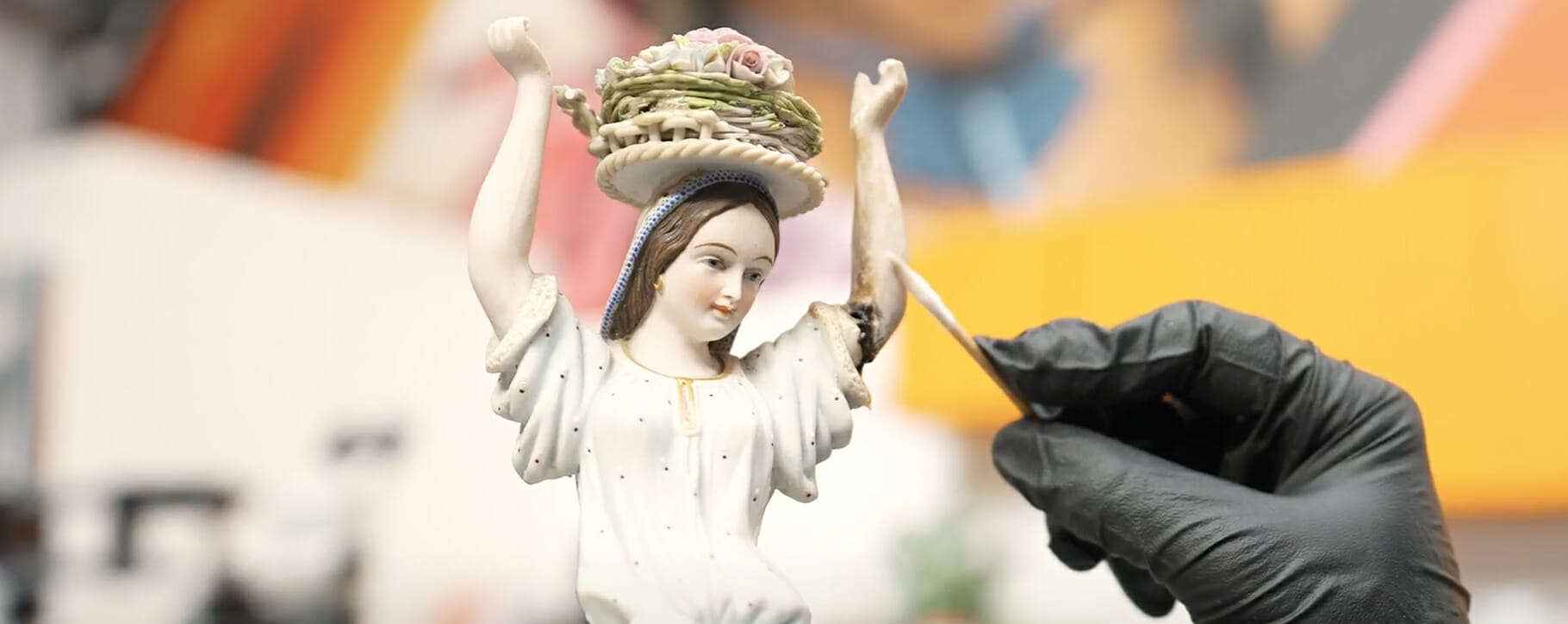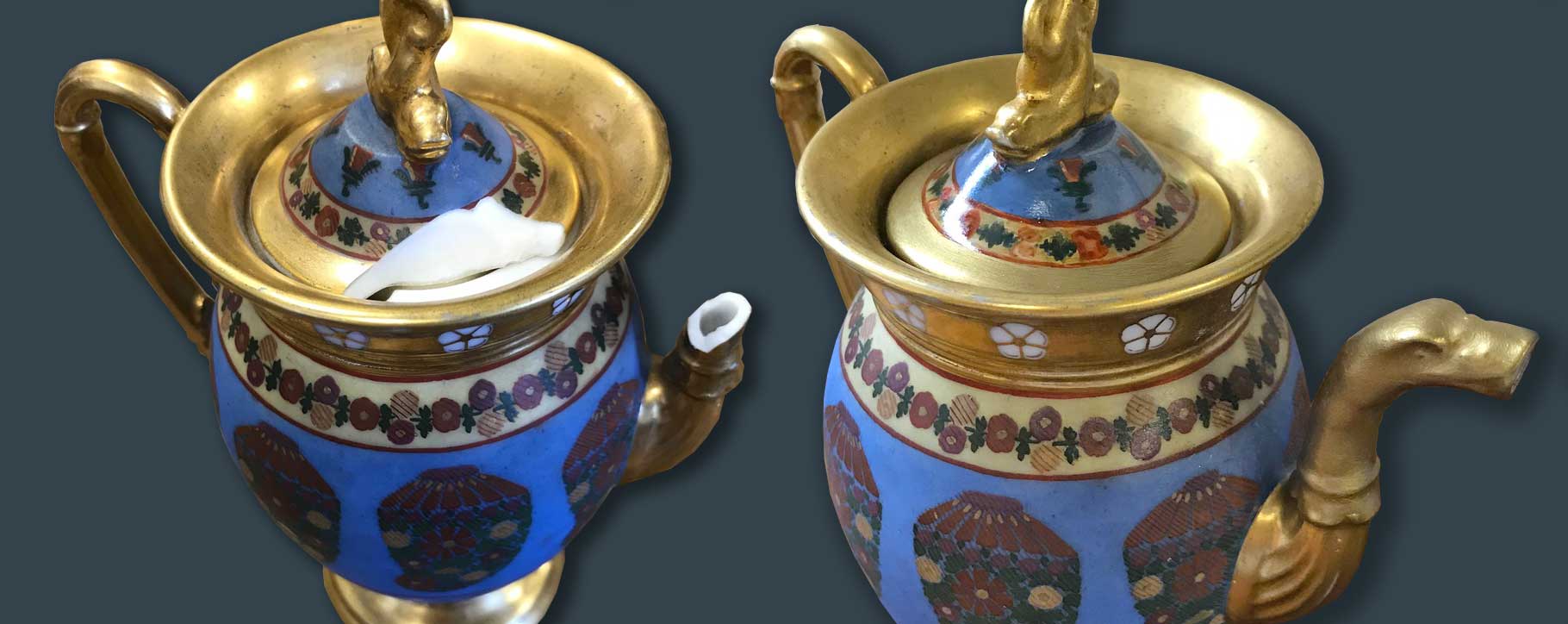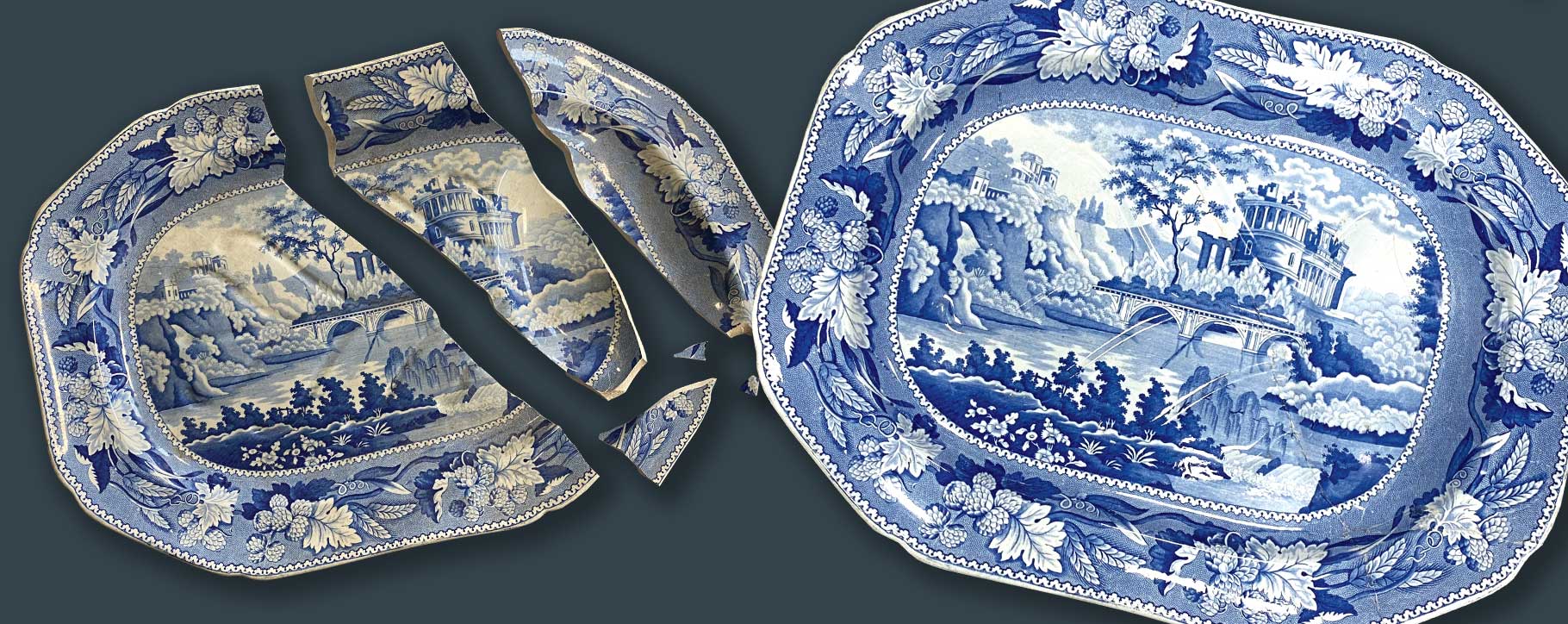
The most catastrophic type of damage to an antique may appear to be when a treasured item is smashed into pieces. Ceramics are at the highest risk of accidental damage from the moment they are picked up or moved. Whether it’s from an accidental nudge, a fall from height, or an unpredictable collision, these damages are most likely to happen when our possessions are outside of their usual safe locations.
When moving items from a home, there is a lot to consider when it comes to the welfare of the artwork. This is especially true of ceramic ornaments, which although may stand up to time more robustly than other antiques, are suddenly in a very vulnerable position when being removed, transported or stored anywhere other than a stable cabinet, shelf or tabletop.

Antique and contemporary ceramics are at risk of various kinds of damage, from small chips and fractures to broken parts or complete fragmentation. These artworks are some of the most sentimental pieces we work on at Fine Art Restoration Company, as they are often given as gifts or collected for pleasure over a lifetime. They can also have great monetary value, as rare items can achieve astonishing prices, due to their appeal in the antiques trade and with the wider public.
Luckily, a range of specialist techniques exists to resolve chips, fractures and even seemingly hopeless breakages after an accident. Our conservator who specialises in ceramics can achieve seamless repairs in most cases, allowing the treasured object to fit back in with its collection, or to go on and achieve a high asking price at auction. But to avoid the breakage in the first place, this article will cover what to look out for when arranging for ceramics to be put in the high-risk position of being moved, transported and stored.

Weak points to watch out for:
- Unglazed paintwork, gilding or details painted above the glazed layer, which is easily rubbed away.
- Extremities that go beyond the body of the work, which has a small or weak join. Such as the arms and legs on figurines.
- Applied details, such as decorative relief designs and cameo portraits.
- Contrasting areas, where different types of clay or materials have been joined.
- Ensure lids of vases or pots are securely in place in the correct position.
How to safely move ceramics
Despite the potential for fragile ornaments to smash, many ceramics are actually more durable than other forms of artwork. This is seen in works from ancient china and intricate baroque eras, which live on today with their fine details intact. Glazed ceramics are often the most well-kept, as like varnish on an oil painting, it preserves the layer beneath. The porous nature of ceramics means that an unglazed piece is more vulnerable, but generally, they are extremely long-lasting if accidental damage is avoided. With this in mind, the handling of these objects is of the uppermost importance.
Firstly, it is important to assess ceramics for the nature of their decoration and any potential weak points. Before you pick up the work, check it well for any loose parts such as a lid, broken/badly fractured pieces, or secondary display items. This will ensure nothing falls away when you’re ready to move it.
When handling ceramic items you do not need to wear gloves, as these may make accidental damage more likely. Gloves will risk having less sensitivity in your hands and thus missing small details or having them caught on extremities. A clean pair of hands is best, making sure that they are also dry and free of sweat to avoid items slipping out of your grip or marking an unglazed ceramic with the natural oils from your skin.

After you pick up the item, immediately bring it gently towards yourself and hold the base. Even an item that appears secure may have hidden areas of weakness. Now that the object is away from its stable display area, it is at the greatest risk of breakage and will remain in this high-risk environment until it is settled once again in a new location. Make sure that you know the path you’re going to take and be confident to avoid any potential trip hazards along the way.
How to safely package and transport ceramics
Ceramics should ideally be kept in their own box during storage. You can create a safe box for a ceramic item by lining a strong container with foam and paper. Make sure that these materials do not contain anything acidic, such as ink or other chemicals. Do not use the common option of newspaper, as this could rub harmful elements onto the delicate surface of your ornament, plain tissue paper is best. Pack the matching lid or extra features in a separate box, as putting them together heightens the risk of breakage.
If you are packing an item for transport, the box should be firm in structure, made from a material that is unable to be misshapen when packed into tight areas. Inside this box, the item should be securely wrapped to avoid movement, but not too tightly wrapped that the ceramic itself is under pressure.

You can use bubble wrap, polystyrene to secure the piece in place after it has been covered in acid-free tissue paper. Number or name the box so it is easy to remember, and ensure that it is marked as an extremely fragile item.
A painted or coloured ceramic that is fully glazed has its decoration well protected, however, some ceramics have their decoration painted over the glaze, especially if there is a metallic or gilded level of detail. These areas are prone to scratches or rubbing away entirely, so if this is noticed during your assessment of the piece, ensure that it is kept suitably stable with an inability for these areas to be continuously moved across a surface during the motion of transport or carrying.
When you need to transport antique or contemporary artwork of any kind, it is important to understand the most suitable ways in which to do this that will minimise any risk of damage. If artworks and items are of notable value, it may be worth seeking specialist advice from us on how best to undertake this and reduce risk.

What do I do if a ceramic has been damaged?
The first and most important action after a breakage is to gather any and all of the fragments. The more fragments are saved, the more historic and artistic integrity the item will have when a specialist ceramics conservator restores it. Additionally, it helps to minimise the escalation of the cost of restoration by ensuring as many pieces are gathered and included should an incident occur. If you are missing areas, do not worry. Specialist techniques exist to replace missing pieces with an invisible join.
Act promptly to make sure that the ceramic can be returned to a stable state quickly, as leaving it may encourage new cracks to form and for the porous interior to be open to the elements.
Never attempt to repair a ceramic without the skills and experience needed. Even fixing what appears to be a simple break with ordinary super glue and adhesive materials will lead to discolouration and dangerous deterioration.

Many ceramics come to us with a variety of backstories as to how accidental damage has occurred. From small chips to shattered fragments, our clients are happy to hear that we are able to assist them with the seamless restoration of their treasured objects. Ceramics are diverse in nature, frequent requests we receive for restoration include Lladro figurines, memorabilia ornaments, and ancient Chinese sculptures.
Our ceramics conservator recently worked on a much-loved item of an ancient pottery mask. It had been involved in an accidental damage incident and unfortunately had smashed in pieces. Our client was devastated. When it returned to them, perfectly restored, they were so astonished at the perfect results that they asked; “Can you promise this is mine? You didn’t buy me a new one?” The invisible repair allowed the sentimental piece to return home, as if the breakage had never taken place, continuing to be admired and enjoyed.
If you’d like more information or advice on ceramic restoration or storage, please contact our team via email [email protected]







